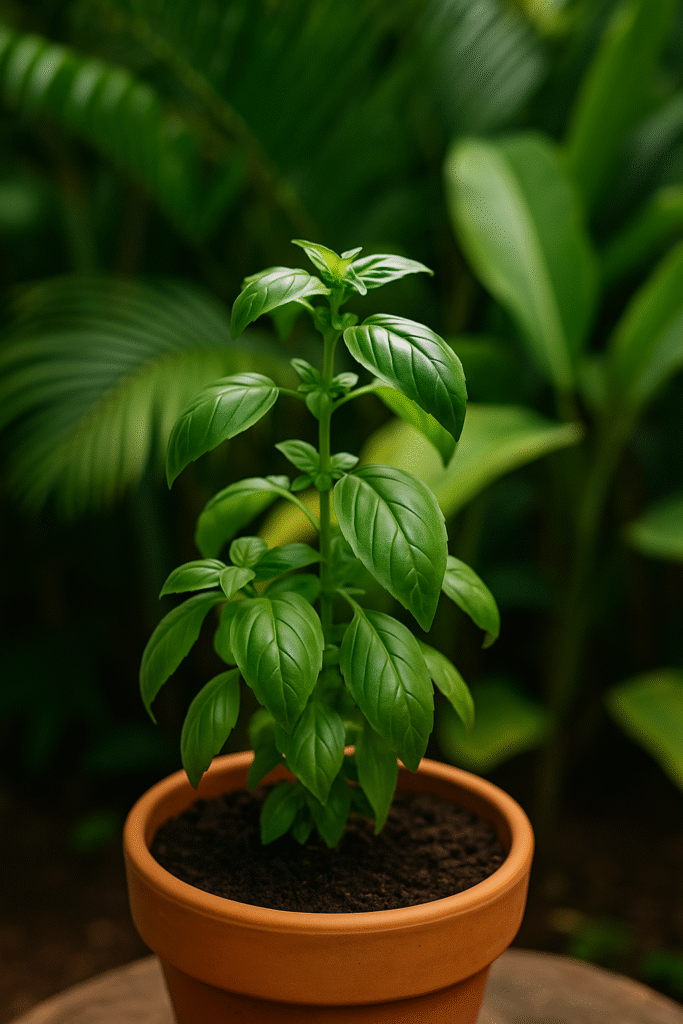Basil (Ocimum basilicum) is one of the world’s most beloved herbs. Known for its aromatic leaves and versatile culinary applications, basil is a staple in Mediterranean and Asian cuisines. But did you know that this plant — native to tropical regions of Asia and Africa — has become widely cultivated and deeply integrated into the culture of Brazil?
In this article, we’ll explore the health benefits of basil, its popular uses in cooking, and how it thrives in Brazil’s tropical climate. Even if you’re in the U.S., understanding how basil adapts to different environments — like Brazil — can help you grow and care for this herb more effectively at home.
A Tropical Traveler: How Basil Found a Home in Brazil
Basil was introduced to the Americas by European colonizers, but it quickly made its way into Brazilian gardens due to the country’s favorable climate. Though not native to Brazil, basil has adapted exceptionally well to the country’s warm, humid conditions. Today, it is found in everything from backyard gardens to small urban balconies across Brazil.
In Brazil, this fragrant herb is often grown alongside other medicinal and culinary plants like mint, rosemary, and lemongrass, forming what locals call “hortas caseiras” (home gardens). Its resilience and rapid growth make it a favorite among Brazilian gardeners and cooks alike.
This adaptation shows how the plant is not only a global herb, but also one that responds well to tropical climates — useful knowledge if you’re cultivating it in Southern U.S. states like Florida, Texas, or California, where similar conditions exist.
Health Benefits of Basil
This popular culinary herb isn’t just a flavorful addition to food — it’s also a powerhouse of health-supporting compounds. Here are some of the top health benefits associated with fresh leaves:
1. Rich in Antioxidants
Basil contains powerful compounds like eugenol, linalool, and flavonoids, which help combat oxidative stress and protect the body’s cells from free radical damage.
2. Anti-Inflammatory Properties
Eugenol, found in high quantities in this herb’s essential oil, acts as a natural anti-inflammatory. Regular consumption can help reduce inflammation-related symptoms.
3. Supports Digestion
In Brazilian folk medicine, basil tea is commonly used to relieve bloating, gas, and indigestion. These uses are supported by basil’s antispasmodic and carminative effects.
4. Natural Stress Reliever
Many cultures, including Brazilians, use basil infusions to relieve mild anxiety and tension. The scent alone can have calming effects on the nervous system.
5. Boosts Immunity
Basil’s antibacterial and antifungal properties make it an effective natural remedy to support the immune system and ward off infections.
Culinary Uses: From Italy to Brazil
This herb’s sweet, slightly spicy flavor has earned it a key spot in global cuisines. In Brazil, it is used in:
- Pasta dishes and sauces, similar to Italian uses.
- Fresh salads, especially with tomatoes and soft cheeses.
- Herbal teas, often combined with mint or lemon balm.
- Rice and beans, adding a fragrant layer to traditional meals.
- Natural pestos, using local ingredients like Brazil nuts or cashews instead of pine nuts.
In the U.S., this aromatic herb remains a favorite in Caprese salad, pesto sauces, pizza, and infused oils.
How to Grow Basil — Inspired by Brazilian Gardens
Thanks to its successful cultivation in Brazil, we can borrow some tropical-growing tips that work just as well in American home gardens. Here’s how to grow healthy basil based on techniques used in Brazil:
1. Choose a Sunny Spot
Basil needs at least 6 hours of sunlight per day. In Brazil, it grows year-round thanks to abundant sun — mimic this by placing your basil near a south-facing window or outdoors during warmer months.
2. Use Nutrient-Rich Soil
Brazilians often mix compost and organic matter into the soil. A well-draining potting mix with compost will help you replicate this and promote lush, green leaves.
3. Water Properly
In Brazil’s tropical climate, this aromatic plant thrives with regular watering. Keep the soil moist but never soggy. Water in the early morning to avoid mildew or leaf fungus.
4. Frequent Pruning
Just like in Brazilian home gardens, pinch off the top leaves regularly to encourage bushy growth and prevent the plant from flowering too early.
5. Grow in Containers or Beds
In cities like São Paulo or Rio de Janeiro, basil is commonly grown in containers on balconies. This method works perfectly for urban dwellers in the U.S. too.
Varieties You Might Encounter
While sweet varieties are the most common, Brazil also cultivates several unique types, including:
- Purple basil, with its dramatic color and spicy notes.
- Lemon basil, popular for teas and desserts.
- Brazilian basil (Alfavaca), often confused with sweet basil, but technically a different species (Ocimum gratissimum) with a more clove-like scent.
These varieties can add diversity to your herb garden and culinary creations.
Conclusion: A Global Herb with Local Roots
Basil is a truly global herb — adaptable, flavorful, and beneficial to health. Although not native to Brazil, it has become an essential part of the country’s herbal culture, thanks to its easy cultivation and tropical adaptability. Learning how basil thrives in Brazil can inspire new ways for Americans to grow and use this powerful herb at home.
Whether you’re a home chef, an herbal tea enthusiast, or a backyard gardener, adding basil to your life will enrich both your plate and your well-being.

Discover Rare and Beautiful Succulents
Looking for unique, healthy, and eye-catching succulents? At Leaf & Clay, you’ll find exotic varieties perfect for any indoor garden or tropical plant collection.
Explore their curated selection and get inspired to grow something extraordinary today!

